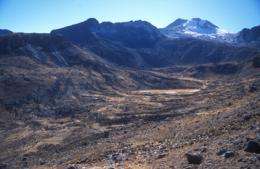Causes of melting tropical glaciers identified

The causes of melting of tropical glaciers over the past 10 000 years have at last been unveiled by a team of French researchers from CNRS, CEA, IRD and Universite Joseph Fourrier, together with a US researcher from the University at Albany (State University of New York). They have shown that the retreat of the Telata glacier in Bolivia over that period is mainly linked to a 3 C rise in air temperature and to the warming of the tropical Pacific Ocean in response to an increase in insolation. Their work was published on 09 June 2011 on the website of the journal Nature.
In the collective imagination, "tropical glacier" seems to be a contradiction in terms. And yet tropical glaciers do exist, mainly in the Andes. To identify the causes of their retreat, it is necessary to understand their recent history.
The team of researchers studied one of the high-altitude glaciers in the Cordillera Real range in Bolivia, called the Telata. The moraines (rocks deposited by the glacier, marking its earlier positions) from the Telata, which are numerous and very well preserved, make this a unique site in tropical regions. This is because they provide an almost unbroken record of successive glacial stages. The moraines were dated by measuring the concentration of certain elements in the rocks, thus making it possible for the first time to reconstruct the history of the glacier during the Holocene, in other words over the past 10 000 years. During that period, the surface area of the glacier decreased and its front retreated by 3 km. The glacial retreat, which was initially slow, has accelerated since the beginning of the 19th century, retreating by 2 km since 1820.
The researchers from the various laboratories involved studied the possible link between the glacial volume and the prevailing temperature and precipitation values for different positions of the glacier in the past. Calculations show that the glacier's retreat is mainly linked to warming of around 3 °C over the whole Holocene period. The very gradual increase in solar radiation at the Earth's surface affected the surface temperature of the tropical Pacific Ocean as well as the climate in the vicinity of the glacier. The increase in temperatures modified the behavior of the glacier and explains why it has retreated. However, numerical simulations with climate models show that variation in precipitation over the past 10 000 years was insufficient to affect the evolution of the glacier.
This is the first time that a study shows that the melting of these glaciers during the Holocene was closely connected to variations in surface temperatures of the tropical Pacific Ocean. The research therefore confirms the exceptional nature of the rapid melting observed since the industrial revolution. Melting since 1820 is not linked to variations in insolation but to other mechanisms. This work shows the extreme vulnerability, over the next decades, of these tropical glaciers, which are located at high altitude in an area where warming in the 21st century is predicted to be at its highest (4-5 °C in the Telata region).
More information: Irregular tropical glacier retreat over the Holocene epoch driven by progressive warming, Vincent Jomelli, et al.,Nature, 09 June 2011.
Provided by CNRS


















